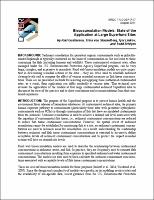Please use this identifier to cite or link to this item:
https://hdl.handle.net/11681/8680| Title: | Bioaccumulation models: state of the application at large superfund sites |
| Authors: | Von Stackelberg, Trina Linkov, Igor Bridges, Todd S. Gustavson, Karl E. |
| Keywords: | Organic water pollutants Bioaccumulation Contaminated sediments Dredging Operations and Environmental Research Program (U.S.) |
| Publisher: | Engineer Research and Development Center (U.S.) |
| Series/Report no.: | Technical Note (Dredging Operations and Environmental Research Program (U.S.)) ; no.ERDC TN-DOER-R17 |
| Abstract: | BACKGROUND: Sediment remediation for persistent organic contaminants such as polychlorinated biphenyls is typically conducted on the basis of contamination in fish and risks to those consuming the fish (including humans and wildlife). These contaminated sediment sites, often managed under the U.S. Environmental Protection Agency Superfund program, can be very large, complex, and expensive to remediate. Food web bioaccumulation models are quite important in determining remedial actions at the sites – they are often used to establish sediment cleanup levels and to compare the effect of various remedial scenarios on fish tissue concentrations. There are no prescribed methods for selecting and applying these methods at contaminated sites; as a result, their application can differ markedly at various sites. This technical note reviews the application of the models at four large contaminated sediment Superfund sites to document the state of the practice and to draw conclusions and recommendations from that combined experience. |
| Description: | Technical Note |
| Gov't Doc #: | ERDC TN-DOER-R17 |
| Rights: | Approved for public release; distribution is unlimited |
| URI: | http://hdl.handle.net/11681/8680 |
| Appears in Collections: | Technical Note |
Files in This Item:
| File | Description | Size | Format | |
|---|---|---|---|---|
| TN-DOER-R17.pdf | ERDC TN-DOER-R17 | 473.98 kB | Adobe PDF |  View/Open |